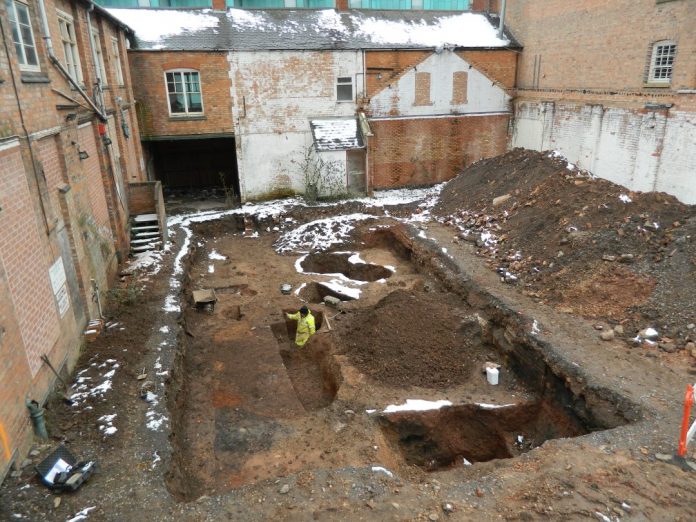
It seems like yesterday, but five years ago today (Sunday 15 March 2015) the first stage of King Richard III’s reburial, the coffining of his mortal remains, took place at the University of Leicester in preparation for his reburial at Leicester Cathedral two weeks later. Mathew Morris, Project Officer for ULAS and site director of the Greyfriars Project reflects on events that day five years ago.
Understandably, a lot of thought went into the preparations. It is not every day you have to rebury a king, let alone one who died in a different age, over five centuries ago. A person whose life is still debated today, whose death marked the end of medieval England and the start of the English Renaissance, and whose discovery in 2012 sparked worldwide interest on a scale rarely seen for archaeological discoveries. What was appropriate? If medieval traditions were followed, would they appear too contrived? Would a more contemporary theme be unsympathetic to the occasion?
From the beginning, we felt that traditional craft methods should be used, and all materials should be sourced from the British Isles, should be natural, and should have been available in the medieval period. The wooden coffin would be made of English oak and yew, sourced from the Duchy of Cornwall. Michael Ibsen, a cabinetmaker and Richard III’s great-nephew many times over, made the coffin, ultimately choosing a rectangular shape rather than tapered to allow the pall to hang properly over it during the time it lay in repose in Leicester Cathedral.


Inside would be a lead ossuary containing the bones. Leicester firm Norman & Underwood used traditional sand cast techniques and 60kg of lead to make the 1.7m long box. Weight would be an issue and there were discussions on its size and whether it would be too heavy to carry. Could the bones by laid out anatomically, or would they have to be packed in an unarticulated manner? Experiments with plastic bones and cardboard coffin prototypes sought to work out the best arrangement for the bones and size of coffin.

How the bones were packed was also a concern. They could not be loose to rattle around unprotected in the coffin as it travelled in the cortege around the county, but whilst we did not want to cause them undue damage; neither did we want to deliberately extend the natural lifespan of the bones using synthetic conservative materials. From the start we were clear about the outcome. Following the completion of the extensive programme of scientific analysis needed to identify the remains, the University would rebury everything, including all scientific samples and residues collected from the bones. This would be a final act, with no plans to reopen the tomb in the future.
The actual coffining of Richard III’s remains was a private occasion, carried out by members of the research team in the Council Room, formerly a chapel, of the University of Leicester’s Fielding Johnson building. It was witnessed by a small number of representatives from the University and other key organisations, including the Cathedral, the City Council, the County Council, the Richard III Society, members of the University chaplaincy, an independent witness and relatives of King Richard III who donated their DNA as part of the identification process.
In order to secure the bones in the ossuary, a combination of washed natural woollen fleece, wadding and unbleached line were used for the layers of packing. Scientific samples were evaporated and the residues were stored in glass tubes sealed with cork. Linen bags, made by the pupils of the Richard III Infant’s School in Leicester, were used to hold the smaller bones and the scientific samples.

We laid the bones out as if articulated on wool wadding covered with a linen cloth. Wool fleece was packed around each bone to hold it in position. The linen bags containing the smaller bones of the hands and ribs and were placed in the relevant anatomical positions and the scientific samples were placed in another bag at the foot of the coffin. Finally, we covered the bones with more sheets of thick wool wadding to fill the remaining space.
A replica of a 15th-century rosary was placed between the final wool sheets. Lastly, a sheet of unbleached linen was placed on top. This was embroidered by Miss Elizabeth Nokes of the Richard III Society, who used unbleached thread to decorate the cloth with boars, roses and consecration crosses – symbols of Richard III, the House of York and because he was an anointed Christian king. Finally, the lead casket was sealed and Michael Ibsen fixed the lid of the outer coffin in position.

Job done! It was a practical but poignant exercise carried out with dignity and respect. With time to reflect, there was suitable symmetry to the moment. Two and a half years earlier, I was supervising the excavation of the first trench in the now famous carpark when the digger bucket lifted up exposing human bone. Careful investigation revealed it to be a grave and a week later excavation found it to contain the remains of a young male adult with scoliosis, buried in the choir of the Greyfriars church, who died in a horrifically violent manner. Five months later I was in the Council Chamber watching as the University announced to the world that that the bones were indeed Richard III. Two years later, I would be back placing bones into the coffin. I’d seen the story through from beginning to end, from first to see the king’s bones to last.
***

The search for Richard III was initiated by Philippa Langley and enacted by the University of Leicester in collaboration with Leicester City Council and the Richard III Society. If you would like to learn more about the discovery and identification, please visit www.le.ac.uk/richardiii/
Source: ULAS

